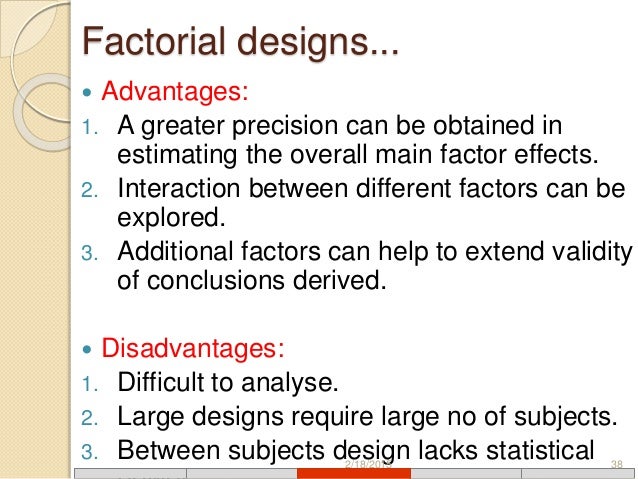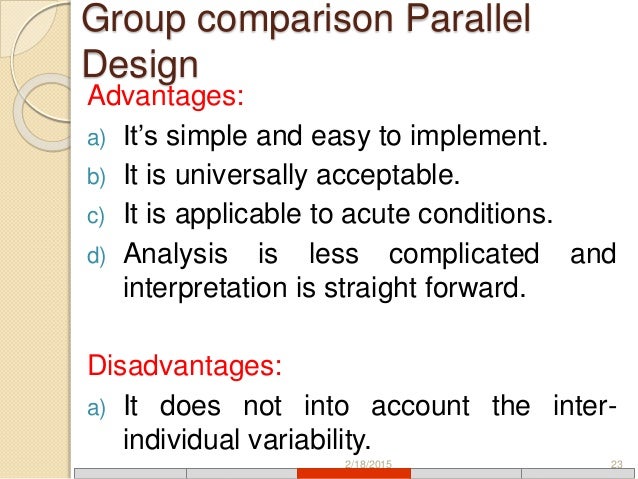42 open-label study disadvantages
› pro › amphotericin-bAmphotericin B - FDA prescribing information, side effects ... Feb 01, 2022 · Amphotericin B Description. Amphotericin B liposome for injection is a sterile, non-pyrogenic lyophilized product for intravenous infusion. Each vial contains 50 mg of Amphotericin B, USP, intercalated into a liposomal membrane consisting of approximately 0.64 mg alpha tocopherol; 52 mg cholesterol; 84 mg distearoylphosphatidylglycerol, sodium salt; 213 mg hydrogenated soy phosphatidylcholine. Open-label extension studies: do they provide meaningful information on ... Negative aspects of open-label extension studies revolve around their use as a marketing tool, as they build a market for the drug and generate pressure for subsidised access to the drug from consumers and their physicians.
› vitamins › aiSOY: Overview, Uses, Side Effects, Precautions ... - WebMD Soy foods are available in many different forms, including tofu, miso, and soy milk. Soy protein products have most often been used by adults in doses of 40 grams by mouth daily for up to 5 months.

Open-label study disadvantages
› pmc › articlesTreatment Strategies for Co-Occurring ADHD and Substance Use ... In contrast to the data described above, a laboratory study of methylphenidate in cocaine-dependent patients receiving treatment did not increase cocaine craving nor ratings associated with abuse potential, 64 suggesting that the context of use, in this case therapeutic, may influence subjective effects and abuse potential. 37 Because the ... Designs of clinical trials - SlideShare Trial with Zelen's design... Advantages: 1. Almost all eligible individuals are included in the trial. 2. Allows the evaluation of true effect of experimental intervention in patients. Disadvantages: 1. Open trials. 2. The statistical power of the study gets compromised if large no of patients choose the standard treatment. 2/18/2015 67 68. External and internal validity of open label or ... - Wiley Online Library In general, a blinded trial is regarded as being less subject to bias than an open trial because it minimizes the impact of knowledge of treatment allocation on post‐randomized treatment decisions and on reporting of outcomes. However, a blinded trial is not always feasible.
Open-label study disadvantages. Investigating Potential Bias in Patient-Reported Outcomes in Open-label ... While open-label bias is an important consideration for PRO results, bias related to knowledge of treatment assignment is not unique to PRO and may also affect other common trial outcomes, including progression-free survival 6 and clinician-reported safety data. For instance, the same forces that may lead patients to report fewer or milder ... Open-Label Extension Studies | SpringerLink The number of open-label extension studies being performed has increased enormously in recent years. Often it is difficult to differentiate between these extension studies and the double-blind, controlled studies that preceded them. If undertaken primarily to gather more patient-years of exposure to the new drug in order to understand and gain confidence in its safety profile, open-label ... en.wikipedia.org › wiki › Retrospective_cohort_studyRetrospective cohort study - Wikipedia A retrospective cohort study, also called a historic cohort study, is a longitudinal cohort study used in medical and psychological research.A cohort of individuals that share a common exposure factor is compared with another group of equivalent individuals not exposed to that factor, to determine the factor's influence on the incidence of a condition such as disease or death. Effects of open-label placebos in clinical trials: a systematic review ... These trials assessed effects of OLPs on back pain, cancer-related fatigue, attention deficit hyperactivity disorder, allergic rhinitis, major depression, irritable bowel syndrome and menopausal...
PDF What Are Open-Label Extension Studies For? In open-label assessment studies, there is a sig-nificant risk of biased assessment. Analysis of all subjects who were randomized (intent to treat analysis) is another important technique, since subjects who drop out can differ in crucial ways from subjects who remain in the study. In open-label extension studies, only a proportion of the sub- Pilot Studies: Common Uses and Misuses | NCCIH Feasibility measures are likely to vary between "open-label" designs, where participants know what they are signing up for, versus a randomized design where they will be assigned to a group. In addition to providing important feasibility data as described above, pilot studies also provide an opportunity for study teams to develop good ... Understanding Clinical Trial Terminology: What is an Open Label ... Often, clinical trials use a double-blind approach: study participants and researchers don't know which treatment the patient is receiving. Alternatively, sometimes, trials are conducted in an open-label fashion, meaning study participants and researchers both know which treatment the patient is receiving. PDF Blinding Sponsors for Open Label Studies: Challenges and Solutions - MWSUG the study is ongoing. The practice helps increase credibility of study results and thus should be followed, particularly for registration studies. In open label studies, in addition to treatment assignment data itself, many other data elements in the CRF data can reveal treatment assignment. Those data elements include (but not limited to): •
Open-label trial - Wikipedia Open-label trials may be appropriate for comparing two similar treatments to determine which is most effective, such as a comparison of different prescription anticoagulants or possible relief from symptoms of some disorders when a placebo is given. An open-label trial may still be randomized. External and internal validity of open label or ... - Wiley Online Library Naturally, in open-label trials in anticoagulation there is a risk of a reporting bias of adverse events. Patients may research the new drug and its side-effects in publications and may be influenced in their reporting behaviour of potential side-effects. Furthermore, investigators may be equally susceptible to a reporting bias. Reducing bias in open-label trials where blinded outcome assessment is ... This can be an issue in trials assessing surgical interventions, device trials, or other non-pharmacologic interventions, which are more difficult to blind than traditional drug trials [ 4 ]. Many such trials are therefore open-label, where patients, clinicians, and care providers are aware of treatment allocations. Open-Label Trial - an overview | ScienceDirect Topics Open-label studies lack the rigor of blinded studies. Since the lack of blinding can introduce significant bias, reserve the use of open-label studies for situations in which blinding is neither feasible nor ethical or in cases where the outcome is completely objective, such as survival. Some situations include: •
External and internal validity of open label or double-blind trials in ... In general, a blinded trial is regarded as being less subject to bias than an open trial because it minimizes the impact of knowledge of treatment allocation on post-randomized treatment decisions and on reporting of outcomes. However, a blinded trial is not always feasible.
Epidemiology and Clinical Research Design, Part 1: Study Types. It is difficult to ensure that the exposed and control groups have the same risk of outcome (other than the exposure). In addition to known baseline characteristics for which the exposed and control groups are matched, there may be unknown prognostic factors that are unevenly distributed in the 2 groups contributing to the outcome.
Open-label study | definition of open-label study by Medical dictionary open-label study: a study in which there is no blinding of treatments.
en.wikipedia.org › wiki › Meta-analysisMeta-analysis - Wikipedia The inverse of the estimates' variance is commonly used as study weight, so that larger studies tend to contribute more than smaller studies to the weighted average. Consequently, when studies within a meta-analysis are dominated by a very large study, the findings from smaller studies are practically ignored.
The Advantages & Disadvantages of Unblinded Sample Size Re ... - Statsols The advantages of unblinded sample size re-estimation clinical trials. Earlier Decisions. You inherit the Group Sequential Design which allows the researcher to stop early for efficacy or futility. This allows the ability to adjust the trial to the reality of what the effect size is telling you will happen in the trial. Reduced Potential Cost.
Open-Label Trial | NIH A type of clinical trial. In open-label trials, both the researchers and participants know which drug (or other intervention) is being given to participants.
NCI Dictionary of Cancer Terms NCI's Dictionary of Cancer Terms provides easy-to-understand definitions for words and phrases related to cancer and medicine.
PDF Labeling and Disadvantages of Labeling 2. Labeling enables professionals to communicate with one another because each categorical label conveys a general idea about learning characteristics. 3. The human mind requires "mental hooks" to think about problems. If present categorical labels were abolished, a new set of descriptors would evolve to take their place. There is ample evidence
› pmc › articlesEffectiveness studies: advantages and disadvantages - PMC The most famous of effectiveness studies on antipsychotics is the CATIE study. 10 There is no doubt that the CATIE study is an important study when one considers, for example, the large sample size (N=1493 in 57 centers), the complex design with several parallel treatment arms, the 18-month duration of treatment of the first phase, inclusion of ...



![[Full text] Role of 3-monthly long-acting injectable paliperidone in ...](https://www.dovepress.com/cr_data/article_fulltext/s150000/150568/img/NDT-150568-F01.png)



Post a Comment for "42 open-label study disadvantages"